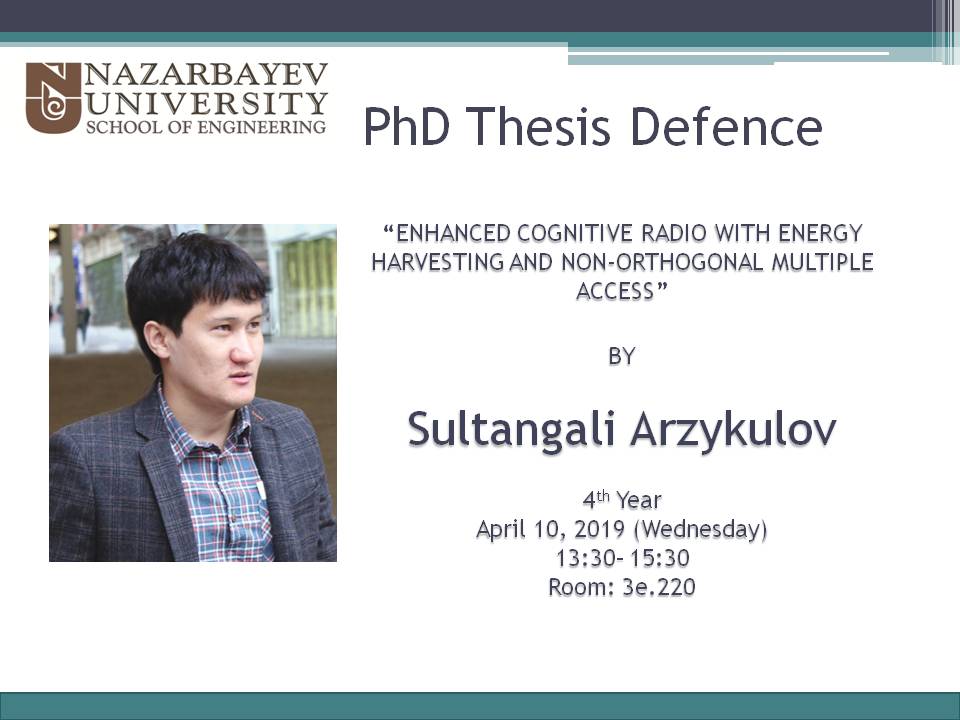10/01/2019 – PhD Thesis Defense

Nazarbayev University's PhD Program in Science, Engineering and Technology is delighted to invite you to the PhD Thesis Defense:
Candidate: Sultangali Arzykulov, PhD student
Thesis Title: "ENHANCED COGNITIVE RADIO WITH ENERGY HARVESTING AND NON-ORTHOGONAL MULTIPLE ACCESS ".
Lead Supervisor: Professor Behrouz Maham, Dept. of Electrical and Computer Eng., School of Engineering, Nazarbayev University, Kazakhstan
Co-Supervisor: Professor Refik Kizilirmak , Dept. of Electrical and Computer Eng., School of Engineering, Nazarbayev University, Kazakhstan
External Supervisor: Professor Theodoros Tsiftsis, School of Intelligent Systems Science & Engineering, Jinan University (Zhuhai Campus), Zhuhai, Guangdong Province (China).
Chair-Internal Examiner: Professor Luis Rojas-Solórzano, Dept. of Mechanical and Aerospace Eng., School of Engineering, Nazarbayev University, Kazakhstan
Internal Examiner: Professor Mohammad Shabi Hashmi, Dept. of Electrical and Computer Eng., School of Engineering, Nazarbayev University, Kazakhstan
External Examiner: Professor Mohamed-Slim Alouini, Electrical Engineering, Associate Dean and Professor, Computer, Electrical and Mathematical Science and Engineering, KAUST, Saudi Arabia.
Abstract:
The increasing demand for wireless applications is making radio spectrum scarce. Meantime, studies show that the assigned spectrum is not thoroughly utilized. The cognitive radio (CR) technology is proposed as a feasible key technology to solve issues related to the spectrum scarcity. CR can improve spectrum utilization by reusing the unused spectrum occupied by licensed users. Introduction of CR networks produces two kinds of interference: interference from the CR network (secondary network) to the primary network (PN) and the interference among secondary users. All unwanted interference should be adequately managed in order not to jeopardize the performance of the PN and at the same time improve the performance of CR systems. Interference alignment (IA) is a promising technique that can efficiently manage interference. One of the aims of this thesis is to mitigate the interference by deploying multiple antennas at both transmitter and receiver sides in order to improve the performance of CR networks.
The rapid growth of data-hungry wireless applications is forcing us to perform energy harvesting (EH) from external power sources for the next-generation of wireless communication systems. Especially, CR networks, where receiver nodes need advanced hardware to process a large amount of data, require higher energy consumption. Thus, another goal of the current thesis is to investigate simultaneous wireless information and power transfer (SWIPT) in CR networks in the presence of intra- and inter-network interference over various channel state conditions.
Firstly, a cooperative CR network is investigated over the general alpha-mu fading channel. The contribution of this study is mainly described by the exact closed-form expression for the outage probability (OP) of secondary users, which clearly shows how the outage saturation paradigm appears when the interference level at the primary receiver is applied.
Secondly, the proposed cooperative CR is extended by applying multiple-input multiple-out (MIMO) antennas and an IA technique to deal with intra- and inter-network interference. The negative effect of interference at both primary and secondary receivers is mitigated by using precoding and interference suppression beamforming matrices. The management of interference at primary receivers allows secondary transmitters to increase the transmit power level. Moreover, the instantaneous capacity performance is assessed for the same CR system by applying two EH methods, i.e., time-switching (TS) and power-splitting (PS). Then, the optimal values of TS and PS portions are determined for different channel state information (CSI) scenarios. In addition, the effect of imperfect CSI on bit error rate and capacity performance is provided.
Finally, we jointly study a cooperative CR and non-orthogonal multiple access (NOMA), where we derive closed-form expressions for the OP of NOMA secondary destination users for detect-and-forward and amplify-and-forward relaying techniques. Furthermore, power allocation factors for different distances of secondary NOMA users are found to satisfy OP fairness for all users. In addition, the proposed CR-NOMA network model is further studied with enabled SWIPT technology.
Date and time: April 10, 2019 (Wednesday) at 13:30 am, room 3e.220



